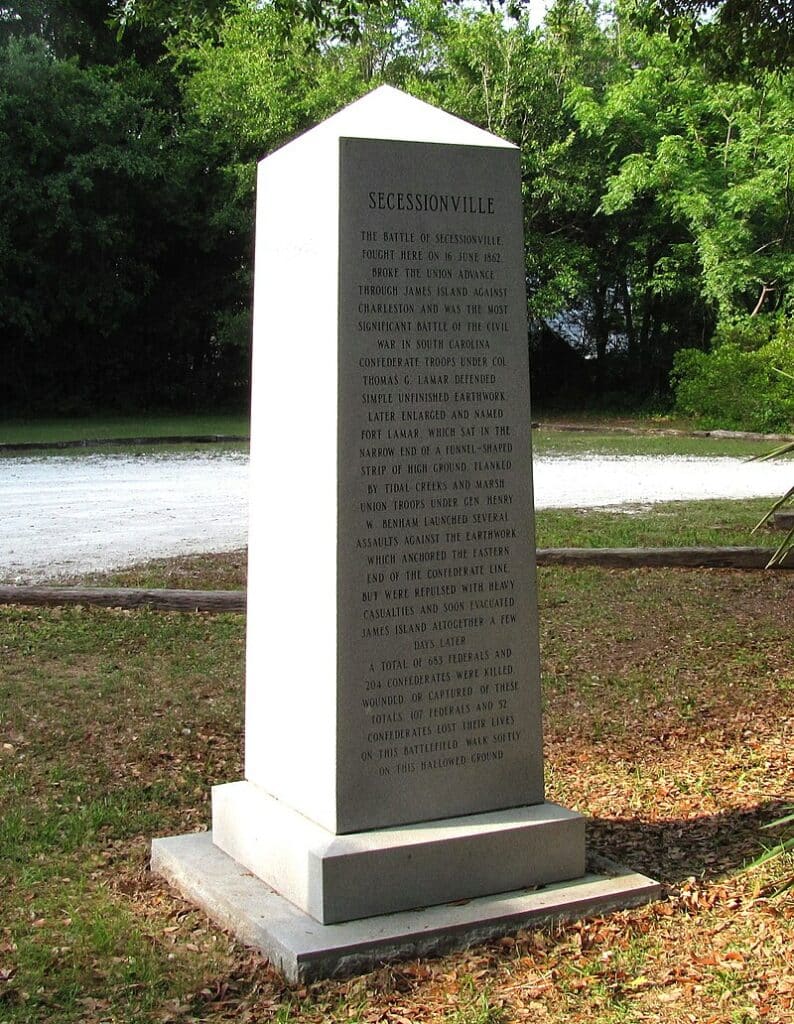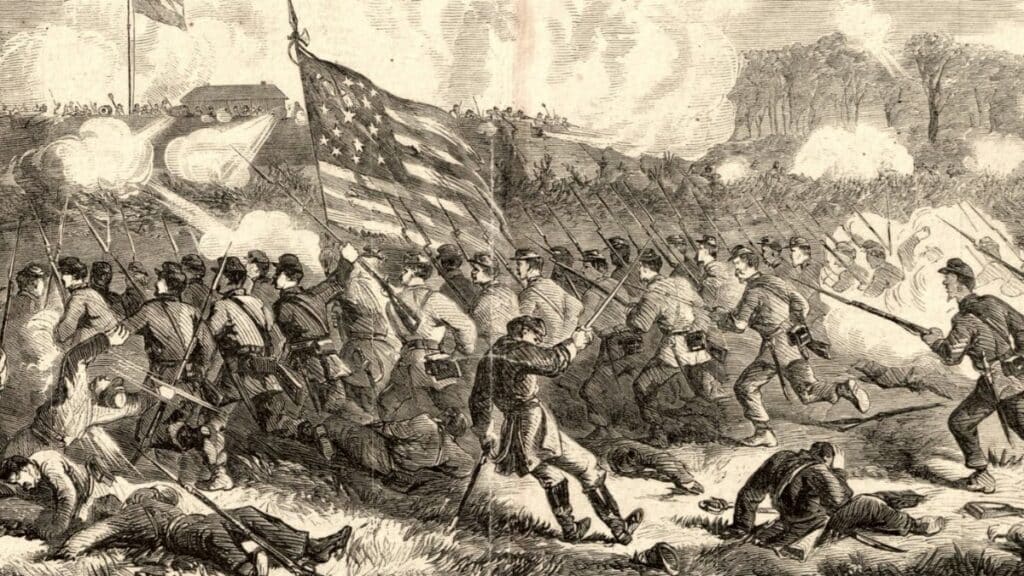Fort Lamar is a historical gem located on James Island in South Carolina. It attracts the interest of history enthusiasts and travelers alike.
Fort Lamar played a significant role in the Civil War, specifically during the Battle of Secessionville. Its strategic location provides a unique glimpse into past military strategies.
Although the fort’s remains are not extensive, they offer a poignant reminder of the intense fighting on James Island.
Visitors can explore the site to get a sense of the challenges and tactics that shaped the course of the war in South Carolina. This historic site educates and encapsulates the region’s rich heritage.
History of Fort Lamar

Fort Lamar is significant in Charleston’s history during the American Civil War.
Its origins trace back to the Confederates’ early defensive strategies, and it played a crucial role during the Siege of Charleston. Key events and figures are tied to its story.
Origins of Fort Lamar
Fort Lamar, initially constructed by Confederate troops in 1862, was part of Charleston’s broader defense system.
Located in Secessionville on James Island, it was named after Brigadier General Thomas G. Lamar.
The James Island planters fortified the area to protect Charleston from Union advances.
The fort’s strategic position offered control over crucial waterways, deterring Union naval and land approaches. It was made from earthworks and utilized artillery battering to fortify against impending attacks.
Fort Lamar was invaluable in the Confederates’ strategy to defend vital Southern port cities during the Civil War. Its existence is a testament to the military foresight of Confederate leadership.
The Siege of Charleston
The Siege of Charleston in 1864 highlighted Fort Lamar’s defensive importance.
Union forces targeted Charleston, viewing it as a pivotal Confederate stronghold. Fort Sumter, already famous from the war’s beginning, continued to be a focal point.
The engagement at Fort Lamar on June 16, 1862, known as the Battle of Secessionville, saw Confederate troops fend off a Union advance.
Despite being outnumbered, Lamar’s command successfully held their ground. This victory bolstered Confederate morale and hindered Union efforts to capture Charleston for two more years.
Fort Lamar’s resilience and the effective strategies employed during the siege exemplify the intense military confrontations typical of the Civil War era.
The Battle of Secessionville

The Battle of Secessionville, fought on June 16, 1862, was a pivotal engagement on James Island.
The Confederate forces, despite being heavily outnumbered, successfully repelled the Union Army, securing Charleston for the Confederacy.
Key Figures
Thomas G. Lamar commanded the Confederate forces. A skilled strategist, Lamar took a defensive position at Tower Battery, bolstering the Confederates’ chances. His leadership was crucial in the Confederates’ ability to fend off the Union attack.
On the Union side, Henry Benham led the assault but was eventually relieved of command due to his failure. Horatio G. Wright and David Hunter also played significant roles, albeit with limited success.
John C. Pemberton oversaw Confederate operations in the Charleston area and coordinated defense strategies.
Battle Overview
Union forces launched a pre-dawn attack, believing they could take Secessionville by surprise. Their goal was to capture Charleston via James Island.
Confederate troops fortified themselves at Tower Battery, making it difficult for the Union to advance.
The Union Army struggled with the marshy terrain and strong fortifications. The steep ascent and narrow paths to the fort worked to the Confederates’ advantage.
Fierce resistance and strategic placement of artillery allowed the Confederates to inflict heavy casualties on the Union troops, ultimately forcing a retreat.
Aftermath and Implications
The Union’s defeat at Secessionville had lasting implications. The failure hindered further Union attempts to capture Charleston from the south.
The battle solidified Secessionville Historic District and Secessionville Battlefield as sites of significant historical interest.
Confederate troops’ morale received a considerable boost, reinforcing their resolve.
For the Union, the defeat prompted a reassessment of strategy in the Charleston Theater. The battle underscored the importance of intelligence and terrain in military engagements, influencing future regional operations.
Explore More: 10 Historic Forts in South Carolina
Fort Lamar Site Today
Today, Fort Lamar is a preserved historic site within the Secessionville Historic District on James Island, Charleston County. Offering a glimpse into history, it remains a point of interest for history enthusiasts and tourists.
Preservation Efforts
Fort Lamar’s preservation results from coordinated efforts by local and state agencies. These initiatives focus on maintaining the site’s historical integrity while ensuring its accessibility to the public.
Volunteers and historians work together to keep the grounds in good condition.
Restoration projects to stabilize the remaining earthworks highlight the commitment to preserving its past.
Interpretive signage and educational programs are in place to inform visitors about Fort Lamar’s historical significance. Grants and donations are crucial for continued preservation.
Visiting the Historic Site
Visitors to Fort Lamar can access the site through a designated parking area.
The historic site is part of the larger Secessionville Historic District, making it a convenient stop for those exploring James Island.
Walking trails around the earthworks give a close-up view of the preserved structures. Informational plaques provide insights into the fort’s history and events.
The site is shaded by trees, offering a pleasant environment for bird-watching. Local birds and other wildlife add to the area’s natural beauty, enhancing the overall visiting experience.
A Beacon of Reflection & Education on the Civil War Era

Fort Lamar, situated near Secessionville, played a pivotal role during the Civil War and has since been a point of reflection and education. This section highlights its memorialization and educational aspects, offering insight into its historical importance.
Memorialization
Fort Lamar is a solemn reminder of the sacrifices made during the Battle of Secessionville.
The Washington Light Infantry and other Confederate troops fiercely defended this site, contributing to the local and national narratives of the Civil War.
Commemorative markers and monuments at the Secessionville Historic District honor those who fought and died.
Annual events and reenactments help preserve the memory, fostering a connection between past and present generations on James Island.
Local organizations’ preservation efforts ensure Fort Lamar’s significance and role in the battle remain prominent.
These efforts include maintaining historical accuracy in interpreting and showcasing artifacts and documents related to the conflict.
Education and Interpretation
The educational programs centered around Fort Lamar aim to understand its role in the Civil War comprehensively.
Schools and historical societies organize guided tours, bringing the history of Secessionville and the battlefield to life.
Interpretive panels around the site offer detailed information about the strategies employed during the Battle of Secessionville.
These panels highlight the contributions of groups such as the Washington Light Infantry, making the learning experience engaging.
Furthermore, public lectures and workshops are often held with local historians.
These sessions delve into various aspects of the battle, providing participants with deeper insights into the events that unfolded at Fort Lamar.
Educational outreach also includes digital resources, ensuring that those unable to visit in person can still access valuable information.
These resources help disseminate knowledge and keep the history of Fort Lamar alive in public consciousness.
Environmental & Ecological Aspects
Fort Lamar, located on James Island in Charleston County, has a rich and diverse environment. This section highlights the significant flora and fauna and conservation efforts to maintain biodiversity in the area.
Flora and Fauna
James Island is home to a variety of trees and other vegetation.
Species such as live oaks, pines, and palmettos are prominent. These trees provide habitats for numerous bird species.
The area is home to waterbirds, songbirds, and raptors, making it an important spot for birdwatchers. The island’s marshlands support diverse aquatic life, including fish and crustaceans.
Additionally, Fort Lamar’s unique coastal position provides a habitat for a mix of salt-tolerant plants and other wildlife.
Conservation and Biodiversity
Conservation efforts in and around Fort Lamar focus on preserving its historical and natural heritage.
These efforts include habitat restoration projects, particularly in the marshlands and wooded areas.
Conservation programs aim to protect the diverse bird populations and other wildlife found on James Island.
Various local and state organizations consistently work to mitigate threats from urban development, ensuring the region’s rich biodiversity remains intact.
Monitoring of species and their habitats helps identify critical areas that need protection.
Initiatives also emphasize the importance of community involvement in maintaining the ecological balance.
Fort Lamar in the Broader War Context
Fort Lamar held a significant role during the Civil War, primarily due to its location on James Island near Charleston. It served as a strategic point for the Confederates and saw a notable clash known as the Battle of Secessionville.
Strategic Importance during the Civil War
Fort Lamar was situated on James Island, a crucial point for defending Charleston.
The Confederates fortified this position to stave off Union advances, focusing on controlling access routes. The fort’s proximity to Charleston made it a strategic defense line.
Union forces aimed to capture Fort Lamar to gain a pathway to Charleston. This goal was part of broader campaigns in the Department of the South.
Control of James Island would have allowed the Union to exert pressure on neighboring Morris Island and Sullivan’s Island, key outposts in Charleston’s defense.
Comparative Analysis with Other Battles
The Battle of Secessionville at Fort Lamar is often compared to other Civil War battles for its strategic implications.
Unlike larger engagements such as Gettysburg or Antietam, Secessionville was a smaller conflict but had a significant regional impact. The Confederate victory prevented further Union incursions into Charleston from James Island.
This battle shared similarities with other engagements near key strategic points.
For instance, the fight for Fort Pulaski in Georgia involved the Union’s coastal operations to infiltrate Confederate defenses.
However, Fort Lamar’s defense highlighted the effectiveness of Confederate fortifications and the importance of terrain in the South’s military strategy.

Cory is a website owner and content creator who enjoys fishing, history, coin collecting, and sports, among other hobbies. He is a husband and father of four.
Romans 15:4 For whatever was written in former days was written for our instruction, that through endurance and through the encouragement of the Scriptures we might have hope.

